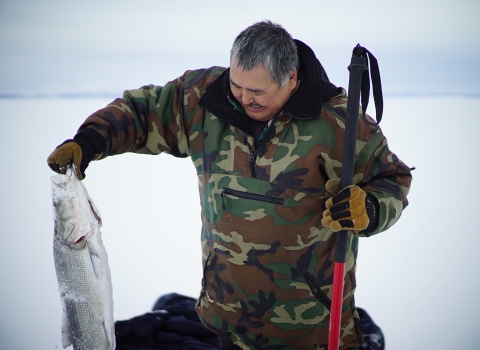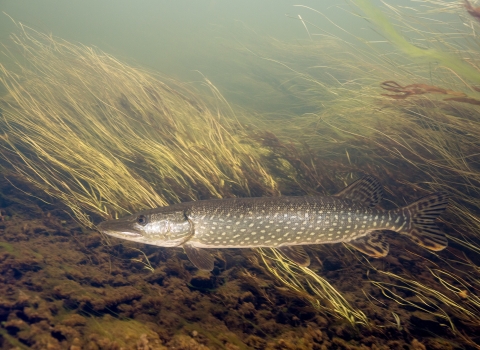The lamprey. Your standard Sea Lamprey and Pacific Lamprey are roughly flute-sized. Arctic Lamprey? Piccolo. But that jawless maw is not an embouchure hole, so you won’t want to put your mouth on it. And those aren’t finger holes, they lead to gills.
Agnathans (a superclass of cartilaginous jawless fish including lampreys and hagfish) have been on earth since before the dinosaurs. And they haven’t changed much. Fossil lampreys that are 360+ million years old look like modern species — a true testament to their success throughout the eons.
Lamprey Lifestyle
Lampreys surprisingly share a lot in common with salmon, including anadromy (a life cycle that begins and ends in freshwater with a journey to sea in between). Anadromous species, like Pacific and Arctic Lampreys, spawn in similar habitats to salmon — gravel bottomed freshwater streams — to ensure their offspring start life in a suitable nursery.
They begin life as a filter-feeding ammocoetes (larvae). Some species stay in freshwater and continue their best lamprey life consuming detritus and organic matter, but others migrate to sea to exploit larger prey sources.
Unlike salmon (who go to sea to consume nutritious marine prey whole), lampreys that go to sea become parasitic. They find a large fish host to attach to and use their unique mouth parts to rasp a hole in and nourish themselves on the host’s fluids. When done with the meal, they detach. Fishers can recognize the tell-tale, circular lamprey scars on salmon and other lamprey hosts.
Along the eastern and western coastal states where they’re found naturally, lampreys and their hosts have had a long time to co-evolve with each other.
Good Lamprey, Bad Rap
Lamprey have value despite their bad reputation and strange looks (especially in the Great Lakes, where Sea Lamprey have found their way in through the man-made Welland Canal to naïve hosts like Lake Trout). And frankly, they’re just cool.
First, we know they help maintain the health of river ecosystems. River ecologists are learning more about how spawning lamprey clean stones during their nest-building activities. In so doing, they “condition” spawning habitat for salmon whose eggs require clean, well-oxygenated substrate. They also bring nutrients from sea into freshwater that nourish the bugs that young fish eat.
Pacific lamprey are important Pacific coast tribes who prize their rich, fatty meat. In Alaska, Arctic Lamprey are harvested by subsistence fishermen on the Yukon River in winter for subsistence and commercial purposes. They have a rich, fatty flavor.
Medical researchers are also intrigued by the ability of lamprey to heal themselves even after severe nerve damage. There is still a lot to learn about these amazing, ancient fish.
Lampreys lovers, learn more:
Check out the Pacific Lamprey Conservation Initiative. Join with others who are passionate about lampreys. This partnership is a collaboration of Native American tribes and natural resource agencies working to conserve Pacific Lamprey throughout their natural range in California, Oregon, Washington, Idaho, and Alaska. The goal is to achieve long-term persistence of Pacific Lamprey and their habitats and support their traditional tribal cultural use throughout their historic range in the United States. Within the Pacific Lamprey Conservation Initiative, there's an Alaska Regional Management Unit for Pacific Lamprey, and an Alaska Regional Implementation Plan that specifically addresses the status and distribution, threats to, and conservation needs for Alaska’s five lamprey species.
We honor, thank, and celebrate the whole community — individuals, Tribes, Stats, sister agencies, fish enthusiasts, scientists, and others — who have elevated our understanding and love, as people and professionals, of all the fish.
Follow us: FacebookTwitter Apple Podcasts








